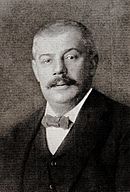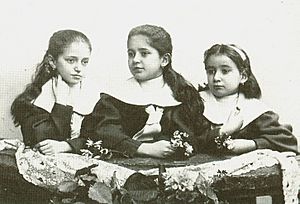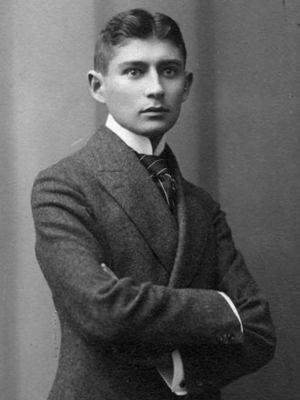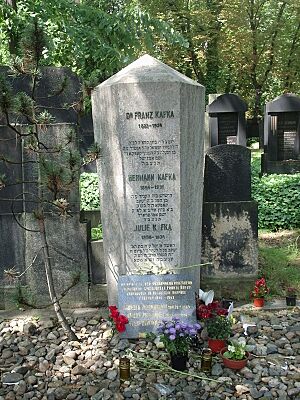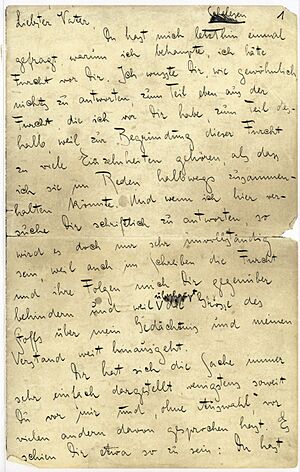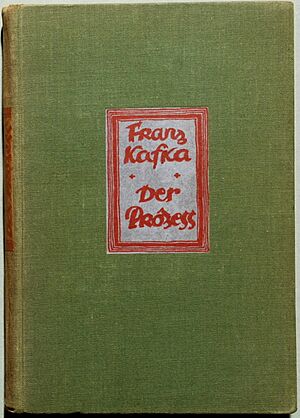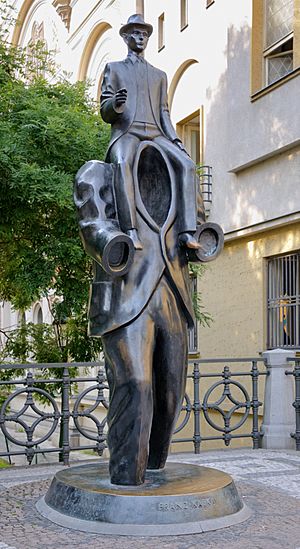Franz Kafka facts for kids
Quick facts for kids
Franz Kafka
|
|
|---|---|
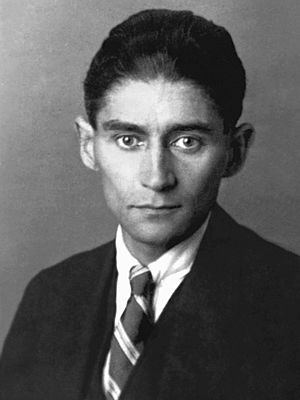
Kafka in 1923
|
|
| Born | 3 July 1883 |
| Died | 3 June 1924 (aged 40) |
| Resting place | New Jewish Cemetery, Prague-Žižkov |
| Citizenship |
|
| Alma mater | German Charles-Ferdinand University, Prague |
| Occupation |
|
|
Notable work
|
|
| Style | Modernism |
| Parent(s) |
|
| Signature | |
Franz Kafka (born July 3, 1883 – died June 3, 1924) was a famous writer from Prague. He wrote novels and short stories in German. Many people consider him one of the most important writers of the 20th century.
Kafka's stories often mix real-life events with strange, dream-like situations. His characters usually feel alone and face confusing problems. These problems often come from huge, hard-to-understand systems, like a big government office. His writing explores feelings of being lost, worried, and confused.
Some of his most famous works are the short story "The Metamorphosis" and the novels The Trial and The Castle. The word "Kafkaesque" is now used in English. It describes absurd or confusing situations, much like those in his books.
Kafka was born into a middle-class Jewish family in Prague. At that time, Prague was part of the Austro-Hungarian Empire. He studied law and worked full-time for an insurance company. This meant he could only write in his free time. He wrote many letters to his family and friends. He had a difficult relationship with his father. Kafka was engaged several times but never married. He died at age 40 from tuberculosis, a serious lung disease. He was not well-known when he died.
Kafka wrote a lot, often late at night. He burned about 90% of his writings because he doubted himself. Most of what was left was not published during his lifetime. He asked his friend, Max Brod, to destroy his unfinished works after his death. But Brod did not follow these wishes. Instead, he published many of Kafka's novels and stories. Kafka became famous only after 1945, especially after World War II. His work has greatly influenced many writers and thinkers since then.
Contents
Discovering Franz Kafka's Life
His Early Life and Family
Franz Kafka was born in Prague, which was then part of the Austro-Hungarian Empire. His family was German-speaking and Jewish. His father, Hermann Kafka, was a strong and loud businessman. He owned a fancy goods store. His mother, Julie Kafka, was quieter and more educated.
Kafka's parents often worked long hours. So, Franz and his sisters were mostly raised by nannies. Franz had two younger brothers who died as babies. His three sisters were Gabriele ("Ellie"), Valerie ("Valli"), and Ottilie ("Ottla"). Sadly, all three sisters died during World War II in the Holocaust. Ottla was Kafka's favorite sister.
Kafka's relationship with his father was difficult. He wrote a long letter, "Letter to His Father", about how his father's demanding nature affected him. This strong father figure greatly influenced Kafka's writing.
His Education and Friends
From 1889 to 1893, Kafka went to a German elementary school for boys. His Jewish education ended with his bar mitzvah at age 13. He did not enjoy going to the synagogue often.
After elementary school, Kafka attended a strict German high school. He studied German and also learned Czech. He became good at Czech, but he spoke German with a Czech accent. He finished high school in 1901.
In 1901, Kafka started studying chemistry at Charles University in Prague. But after two weeks, he switched to law. He didn't love law, but it offered many job options, which pleased his father. Law school also gave him time to take classes in German studies and art history.
During his first year of law school, Kafka met Max Brod. Brod became his lifelong close friend. Brod later described Kafka as shy but very profound. Kafka loved to read. He and Brod read many classic books together. Kafka earned his law degree in 1906.
His Work Life
In 1907, Kafka started working at an insurance company. He was unhappy because the long hours (8 AM to 6 PM) left him no time to write. He quit after less than a year.
In 1908, he found a better job at the Worker's Accident Insurance Institute. This job involved looking into accidents that happened to factory workers. At that time, safety rules were poor, so many workers lost fingers or limbs. Kafka's job was to investigate these accidents and help workers get compensation.
His father called this job a "bread job," meaning it was just to pay the bills. Kafka often said he disliked it. However, he was quickly promoted. He wrote reports that his bosses liked. He usually finished work by 2 PM, which gave him time for his writing.
Around 1911, Kafka and his brother-in-law started an asbestos factory. Kafka spent a lot of time on this business at first. But he later disliked how it took away from his writing time. During this period, he also became very interested in Yiddish theatre and Jewish culture. He also became a vegetarian.
In 1915, Kafka was called to serve in World War I. But his insurance company job was considered important government work, so he was excused. Later, he tried to join the military but couldn't due to tuberculosis. He was diagnosed with this illness in 1917. In 1918, the insurance institute gave him a pension due to his illness. He spent most of his remaining life in special hospitals called sanatoriums.
His Private Life
Kafka never married. In 1912, he met Felice Bauer. They communicated mostly through letters for five years. They were engaged twice, but the marriages never happened. Kafka's letters to her were later published as Letters to Felice.
Around 1920, Kafka was engaged a third time to Julie Wohryzek. But this marriage also did not happen. Kafka's father did not approve of Julie.
In 1917, Kafka was diagnosed with tuberculosis. He moved to a village in Bohemia for a few months. He felt very comfortable there and called it one of the best times of his life. He kept diaries and wrote many notes.
In 1920, Kafka started a close relationship with Milena Jesenská, a Czech journalist. His letters to her were published as Letters to Milena. In 1923, Kafka met Dora Diamant, a young kindergarten teacher. Hoping to focus on his writing away from his family, Kafka moved to Berlin and lived with Dora. She helped him become interested in the Talmud, a Jewish text.
His Personality
Kafka often worried that people found him unattractive. But those who met him usually found him intelligent and funny. They also thought he was handsome, though serious-looking.
His friend Max Brod said Kafka was one of the most entertaining people he knew. Kafka enjoyed sharing humor and giving good advice. Brod noted Kafka's "absolute truthfulness" and "precise conscientiousness." He looked deeply into small details, finding unexpected truths.
As a child, Kafka wasn't very active. But later, he loved games and physical activities. He was good at riding horses, swimming, and rowing. He enjoyed long hikes with friends. He was also interested in alternative medicine, modern education, airplanes, and films. Writing was very important to him, like a "form of prayer." He needed complete quiet to write.
Some experts have suggested Kafka might have had certain personality traits that influenced his writing. These traits might have made him feel isolated or anxious, which are common themes in his stories.
His Views and Beliefs
Before World War I, Kafka attended meetings of a Czech group that was against war and traditional church power. His friend Hugo Bergmann said Kafka supported socialism. Kafka even wore a red flower to school to show his support.
Kafka was a German-speaking Jew in Prague. He was very interested in the Jews of Eastern Europe, feeling they had a strong spiritual life. His diaries mention many Yiddish writers. However, he sometimes felt disconnected from Jewish life. In his teenage years, he said he was an atheist.
Some scholars believe Kafka's Jewish background influenced his writing, even if it wasn't obvious. He considered moving to Palestine with Felice Bauer and later with Dora Diamant. He studied Hebrew while living in Berlin. Towards the end of his life, he even sent a postcard to a friend in Tel Aviv, saying he wanted to move to Palestine.
Franz Kafka's Death
Kafka's throat tuberculosis got worse. In March 1924, he returned to Prague from Berlin. His sister Ottla and Dora Diamant cared for him. On April 10, he went to a sanatorium near Vienna for treatment. He died there on June 3, 1924.
The cause of death was likely starvation. His throat was too painful for him to eat. At that time, there was no way to feed him through a tube. Kafka was editing his story "A Hunger Artist" on his deathbed. This story is about someone who starves themselves for a performance.
His body was brought back to Prague. He was buried on June 11, 1924, in the New Jewish Cemetery. Kafka was almost unknown during his life. But he became very famous after his death, especially after World War II.
Franz Kafka's Works
Almost all of Kafka's published works were written in German. Only a few letters he wrote to Milena Jesenská were in Czech. The few works published during his lifetime did not get much attention.
Kafka never finished any of his full-length novels. He burned about 90% of his writings. His last partner, Dora Diamant, even helped him burn some drafts. In his early writing years, he was influenced by the writer Heinrich von Kleist.
Kafka also drew and sketched a lot. Until recently, only about 40 of his drawings were known. In 2022, a book called Franz Kafka: The Drawings was published.
His Stories
Kafka's first published works were eight stories. They appeared in a literary magazine in 1908. He wrote "Description of a Struggle" in 1904. His friend Max Brod encouraged him to keep writing and submit it for publication.
In 1912, Kafka wrote "The Judgment" in just one night. He dedicated it to Felice Bauer. This story is often seen as his breakthrough work. It's about the difficult relationship between a son and his strong father. Kafka said writing it felt like "a complete opening of body and soul."
Also in 1912, Kafka wrote "The Metamorphosis" (or "The Transformation"). It was published in 1915. The story starts with a traveling salesman waking up to find himself changed into a giant insect. This story is considered one of the most important works of 20th-century fiction.
Other famous stories include "In the Penal Colony" (1914) and "A Hunger Artist" (1924). "A Hunger Artist" describes a performer who starves himself for long periods. His last story, "Josephine the Singer, or the Mouse Folk", is also about an artist and their audience.

His Novels
Kafka started his first novel in 1912. He called it The Man Who Disappeared. After his death, Max Brod published it as Amerika. This novel was inspired by Kafka's interest in Yiddish theatre. It tells the story of a young man who faces strange situations in an unfair system. It's more humorous than his other works and is the only one for which Kafka thought about a happy ending.
In 1914, Kafka began the novel The Trial. It's about a man who is arrested and put on trial by a distant, mysterious authority. He is never told what his crime is. Kafka did not finish this novel, but he did complete the last chapter.
Kafka started writing The Castle in 1922. The main character, K., is a land surveyor trying to reach the mysterious authorities of a castle. These authorities control the village. The novel is dark and dream-like. It focuses on feelings of being alone, dealing with bureaucracy, and trying to reach an impossible goal.
How His Works Were Published
Kafka's stories first appeared in literary magazines. His first book, Contemplation, was a collection of 18 stories. It was published in 1912. He dedicated it to his friend Max Brod.
His story "The Metamorphosis" was first printed in 1915. Another collection of stories, A Country Doctor, was published in 1919. Kafka prepared a final collection of four stories, A Hunger Artist, which came out in 1924 after his death.
Max Brod's Role
Kafka left all his writings to his friend Max Brod. He clearly told Brod to burn everything unread after his death. But Brod ignored this request. He published Kafka's novels and collected works between 1925 and 1935. Brod said he had told Kafka he wouldn't follow his wishes.
Brod took many of Kafka's unpublished papers with him when he fled to Palestine in 1939. Kafka's last partner, Dora Diamant, also kept some of his notebooks and letters. These were taken by the Gestapo (German secret police) in 1933 and are still missing.
As Brod published Kafka's works, they became widely known and praised. Brod had to arrange Kafka's notebooks, which was hard because Kafka often wrote in different parts of the books. Brod also finished some of Kafka's incomplete works for publication. For example, The Trial had unnumbered chapters, and The Castle had unfinished sentences. Brod organized and edited these.
Modern Editions and Unpublished Papers
In 1961, most of Kafka's original handwritten works were bought by the Oxford Bodleian Library. The text for The Trial was later bought and is now in Germany. Experts have since worked to reconstruct the German novels. These new versions are called the "Critical Editions."
When Max Brod died in 1968, he left Kafka's unpublished papers to his secretary, Esther Hoffe. She sold some but kept most for her daughters. A long legal battle began in 2008 between the daughters and the National Library of Israel. The Library argued that the works belonged to the nation of Israel because Brod had moved there.
In 2012, a court ruled that the papers belonged to the National Library. This decision was upheld by the Israeli Supreme Court in 2016. These papers include thousands of unpublished writings.
Franz Kafka's Legacy
His Influence on Culture
Kafka is known for his unique way of seeing the world. He has influenced many writers, artists, and thinkers. Some famous authors influenced by Kafka include Jorge Luis Borges, Albert Camus, Gabriel García Márquez, and Haruki Murakami. Murakami even named a character after Kafka in his novel Kafka on the Shore.
In 1999, experts ranked The Trial and The Castle as two of the most important German novels of the 20th century. Many believe Kafka had a huge impact on 20th-century literature. Max Brod even said that the 20th century might one day be called the "century of Kafka."
Kafka created a world in his stories that felt rigid and bureaucratic. He wrote in a formal, almost scientific way. But his serious stories also had humor. They showed the strange things that happen in a world that is supposed to be logical. His characters often feel trapped, confused, and guilty. They don't understand their surreal world. Many science fiction and dystopian works after Kafka have followed similar themes. Think of books by George Orwell or Ray Bradbury.
Kafka's influence can be seen in many forms of art:
- Ein Landarzt (1951): An opera based on Kafka's story.
- The Trial (1962): A film directed by Orson Welles, who called it his greatest work.
- Kafka (1991): A film starring Jeremy Irons as Kafka, mixing his life and stories.
- Kafka on the Shore (2002): A novel by Haruki Murakami influenced by Kafka.
- Statue of Franz Kafka (2003): A sculpture in Prague.
- "Kafkaesque" (2010): An episode of the TV series Breaking Bad that uses the term.
- Head of Franz Kafka (2014): A moving sculpture in Prague.
What "Kafkaesque" Means
The term "Kafkaesque" describes ideas and situations that remind people of Kafka's writing. It especially refers to his novels The Trial and The Metamorphosis.
For example, a situation is Kafkaesque when a huge, confusing system or bureaucracy overpowers people. This often happens in a strange, dream-like way, making people feel helpless and lost. Characters in a Kafkaesque setting often can't find a clear way out of a confusing situation.
The term is often used in discussions about existentialism. But it's also used in everyday life to describe situations that are incredibly complex, bizarre, or illogical.
Many films and TV shows have been called Kafkaesque. This style is common in dystopian science fiction. Examples include the films Brazil (1985) and Dark City (1998). The TV series The Prisoner and The Twilight Zone are also often described as Kafkaesque.
However, the term is sometimes used too broadly. According to author Ben Marcus, a true Kafkaesque quality involves:
- Powerful use of language.
- A setting that mixes fantasy and reality.
- A feeling of trying hard even when things seem hopeless.
Commemorating Franz Kafka
- 3412 Kafka is an asteroid named after Franz Kafka. It was discovered in 1983.
- Apache Kafka, a computer software platform, is also named after him.
- The Franz Kafka Museum in Prague is dedicated to Kafka and his work. It has an exhibit called The City of K. Franz Kafka and Prague. This exhibit helps visitors experience the world Kafka lived in and wrote about.
- The Franz Kafka Prize is an annual literary award. It was started in 2001 by the Franz Kafka Society and the City of Prague. It honors literature that shows human values and helps with cultural understanding. The award is given to living authors whose work has been published in Czech.
San Diego State University runs the Kafka Project. This project started in 1998 to find Kafka's last writings.
See also
 In Spanish: Franz Kafka para niños
In Spanish: Franz Kafka para niños


